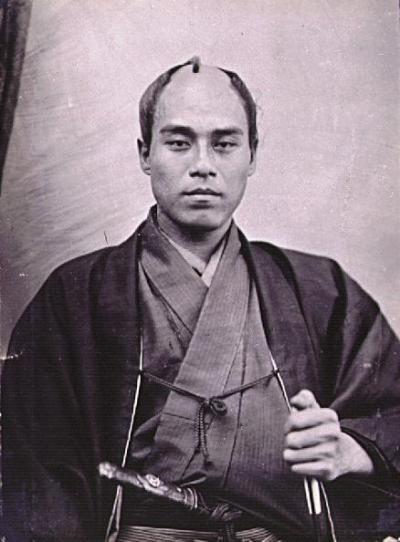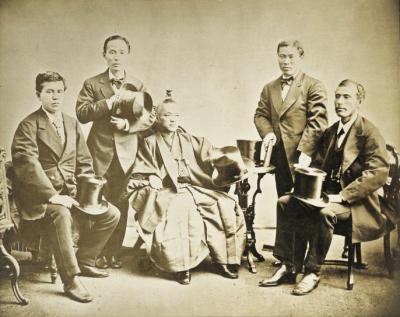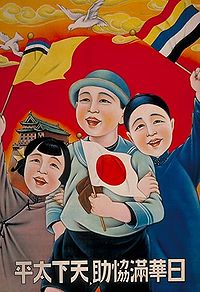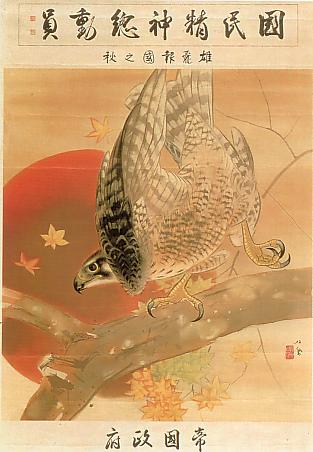Identity and the Rise of Nationalism in Prewar Japan
This complete module with links to all materials may be downloaded as a PDF here.
Aaron Pickering
Oak Ridge High School
Oak Ridge, Tennessee

Fukuzawa Yukichi. Source: Wikipedia at https://tinyurl.com/yawy8vgp.
Estimated module length: Three hours
Overview
This module is designed for an AP world history course, although it could also be used in a standard high school world history course. It primarily addresses Advanced Placement world history standard 6.2.IV.B—"The sources of global conflict in the first half of the century varied and included imperialist expansion by European powers and Japan, competition for resources, the economic crisis engendered by the Great Depression, and the rise of fascist and totalitarian regimes to positions of power.” This module also aligns with the new Tennessee high school world history and geography standards that will be fully operational in fall 2019, particularly standards. W.26— “Analyze Japan’s abandonment of isolationism, its embrace of technological and political changes, and its consequent rise as an imperial power in the late 19th century.”, W.43—“Analyze the role of geographic features and natural resources in increasing tensions prior to and during World War II.,” and W.44—“Compare the Italian, German, and Japanese efforts to expand their empires in the 1930s, including: the invasion of Ethiopia, German militarism, and atrocities in China.”
However, the content and pedagogical strategies for the module are applicable for any high school teachers whose curricula include the development of East Asian states in the pre-World War II era or the development of extreme nationalism and the rise of authoritarian regimes.
Japan’s selective embrace of Westernization during and following the Meiji Restoration set the stage for its emergence as the great independent power in East Asia during the late nineteenth and early twentieth centuries. This module traces this transformation from its origins in the Meiji reforms to the formal invasion of China in 1937. Japanese national identity amid the rapid economic and social changes of the Meiji period was frequently torn between traditional Japanese and East Asian ideas and those of the Western powers. Despite Japan’s adoption of many Western concepts, its attempts to find a place among equals with the Western powers were occasionally rewarded, but repeatedly frustrated. The product of this dynamic was a nationalism that emphasized Japanese exceptionalism among the peoples of Asia and a desire among many to build an empire in East Asia along the lines of the Western powers’ empires elsewhere in Asia, Africa, and the Mideast. Late nineteenth- and early twentieth-century victories in the Ryūkyūs and other islands, along with the acquisition of Formosa (now Taiwan) in the Sino–Japanese War and Korea in the Russo–Japanese War, shaped the public’s willingness to embrace Japan’s growing militarism. The treaties ending both these wars, as well as World War I, left many Japanese frustrated and angry, as they saw many of the spoils of war taken from them by the Western powers. Once the economic difficulties of the Great Depression struck, uncertainty and insecurity on the home front were destabilizing. The civilian government’s inability to offer meaningful solutions mirrored the difficulties faced by civilian governments in the Western democracies as well. The stage was set for the turn to authoritarianism, and the military, particularly the army, was in the best position to offer security and hope. The invasion of Manchuria and associated campaigns emboldened the leadership and provided the resources necessary to move the nation in what appeared to be a positive direction to a hopeful public.
Objectives
Students will:
Evaluate the attitude of Fukuzawa Yukichi and other Meiji reformers toward Western imperial powers and methods, and ascertain the place they envisioned for Japan among world powers at the conclusion of the nineteenth century.
Understand the reasons for Japanese resentment against Western powers that increased following World War I.
Analyze the concept of Kokutai, or “national essence,” and characterize the state of Japanese national identity on the eve of World War II.
Summarize the characteristics of Japanese nationalism in the late nineteenth and early twentieth centuries, and the events that contributed to the development of this national identity.
Prerequisite knowledge
Students should be contextually familiar with various Western interventions in Asia during the early and mid-nineteenth century, particularly the British and Chinese relationship surrounding the Opium Wars and the “American ‘opening’” Japan during the latter Tokugawa period. The events that led to the downfall of the Tokugawa, the success of the Meiji Restoration, and the moves toward Westernization presented by the Meiji reformers (eg, the Iwakura Mission) set the stage for this module. Familiarity with the process of industrialization and the urbanization and modernization that accompany it will help students understand the context of the rise of militarism in Japan. Familiarity with the features of imperialism of the Western powers and their similarity to Japanese imperialism in this period, particularly the occupation of and abuses in Korea, contextualizes the Japanese development of national character.

Leaders of the Iwakura Mission, photographed in London. Source: Wikipedia at https://tinyurl.com/y7fok94c.
Module introduction
Westernization and Japanese identity: “On Leaving Asia”
Estimated time: fifty minutes
The contrast between “Western” civilization and non-Western civilization is a focus in most world history courses, particularly following coverage of the Industrial Revolution and imperialism. Unlike China and its other East Asian neighbors, Japan embraced Western-style industrialization and governmental reforms. Nonetheless, the Meiji government took steps to further the development of a distinct Japanese nationalism that rejected elements of both Chinese and Western culture. Give a brief review of the Meiji Restoration period. Emphasize the experience of China in the Opium Wars and Japanese reactions to the unequal treaty demands of the United States and Europeans in the period leading up to the Meiji Restoration.
Hand out the primary source reading, “On Leaving Asia (Datsu-A Ron)” by Fukuzawa Yukichi, and hand out or display the focus task and questions in the next paragraph. Ask students to read the piece and answer the questions. Pause during the reading and ask students to share a few of the earliest criteria they have found for either Western or Asian nations. Walk them through the textual reference to support these criteria to model the process for the rest of the exercise.
Have students, in small reading groups or as individuals, create a chart with “Western nations” as a header on one side and “Asian nations” on the other. As students read the primary source, have them list at least five qualities of each that the author describes. The students should support each quality listed with a specific reference to the text that supports the criterion. After completing their lists, have students answer these summary questions: (1) Why does the author believe that Japan must embark on a program of de-Asianization? (2) How does the author feel about Westernization and the Western powers? and (3) What place in East Asia and the world does the author propose for a reformed Japan?
Lead students in a brief discussion of their narrative responses. Try to draw out conclusions about Fukuzawa Yukichi’s perspective on the Western nations, and the place that he and other Meiji reformers saw Japan occupying in East Asia and the world stage at the conclusion of the century.
Author’s notes on students’ responses
Perhaps the most interesting part of the discussion centered on the description of the Chinese and Korean peoples by Yukichi. The notion of “bad” friends (notably translated as “evil” in another English translation) and what distinguishes the Japanese from the Chinese and Koreans prompted a debate among my students. Some students observed that Yukichi believed that there are racial differences among East Asians. They suggested that he believed the Japanese are more successful because they are genetically superior. One student questioned to what extent social Darwinism influenced Yukichi. Other students were not sure that the racial superiority was explicit, but instead suggested that Yukichi is showing that the Japanese have to face the same choice as their neighbors. They noted that he regarded Western peoples as no different from their ancestors and attributed their success to transportation technology.
Japanese resentment toward the West and its imperial ambitions
Estimated time: fifty minutes
Despite its embrace of Westernization during the Meiji Restoration, the relationship between Japan and the Western powers was periodically strained and only occasionally resulted in Japan’s treatment as an equal among nations. In both Europe and the United States, Japanese and other East Asian migrants faced significant discrimination. Resentment grew in Japan as the Western nations limited its participation in the imperial process in East Asia.
This lesson presupposes that students are familiar with imperialism and the various abuses and atrocities that Japan committed during the period as an imperial invader, particularly in Korea. For a quick primer on the Japanese occupation of Korea, read the first section on Japan’s colonization of Korea in this 2017 Foreign Policy Research Institute essay by Lucien Ellington and Tawni Hunt Ferrarini for teachers:
Even though the western nations’ double standards of participating in their own imperial ventures while frustrating Japanese efforts had significant impacts on both the Japanese government and populace, this does not justify Japan’s actions nor does it link Japan’s mistreatment by the West to its participation in later atrocities such as The Rape of Nanjing. The concept of the Greater East Asian Co-Prosperity Sphere (colloquially “Asia for Asians”) is one that both justified Japanese imperialism to many and simultaneously drew supporters that genuinely sought cooperation among East Asian nations in the face of western domination.

1935 poster of Manchukuo promoting harmony between Japanese, Chinese, and Manchu. The caption, written from right to left, says: "With the help of Japan, China, and Manchukuo, the world can be in peace." Source: Wikipedia at https://tinyurl.com/q3f3qlo.
Cover or review the treatment of Japanese military successes in the late nineteenth and early twentieth centuries with students. The modernized Japanese military proved itself capable on many occasions, but these military successes failed to earn Japan the respect many of its people sought from the West. Japan took the Liaodong Peninsula during the SinoâJapanese War (1894â1895), but it was pressured by Russia, France, and Germany (and later Great Britain) to give it up. Although the Japanese received some financial compensation, the West largely excluded them from the process of caving up of spheres of influence in China. During the RussoâJapanese War (1904-1905), Japan defeated the Russians and in the Treaty of Portsmouth was granted Korea, Port Arthur, the Kwantung Peninsula, and control of railroads in Manchuria. Despite these gains, riots broke out (most notably the three-day-long Hibiya Riot in Tokyo) when Russia was not forced to pay reparations to Japan.
Although Japanâs participation in World War I was limited, it was among the victors. The pattern of humiliation at the hands of the Western powers continued in the terms of the Treaty of Versailles and the founding of the League of Nations.
Have students read the short piece from the nonprofit organization Facing History and Ourselves âExclusion and Humiliationâ from their 2014 publication The Nanjing Atrocities: Crimes of War.
Ask students to answer the following questions:
How does Makino Nobuaki support the Japanese argument for the inclusion of a racial equality clause?
Why is the equality clause denied even though it passed a vote? Can you think of reasons in addition to those cited that would explain the Western nationsâ opposition?
What might be the motives behind the Japanese delegationâs desire for the racial equality clause?
To what extent have Japanâs actions supported the idea of racial equality in international affairs?
Authorâs notes on studentsâ responses
A few of the studentsâ responses to the second question mentioned the difficulties that the Western powers had when breaking up the AustroâHungarian and Ottoman empires in separate treaties at the end of World War I (which we had recently covered in a separate lesson). One student astutely recalled the situation in Palestine in particular, and we discussed the conflicting commitments of Great Britain there (SykesâPicot Agreement, Balfour Declaration, and commitments to Arab insurgents). The students cited the hypocrisy of the Western powers and the difficulties of giving up their empires.
Although the reading produced empathy for the Japanese delegation, the last question elicited some strong responses from students regarding the Japanese annexation of Korea. One student specifically noted that the Japanese âtried to completely wipe out Korean culture by teaching only Japanese in Korean schools.â Another noted, âKoreans were treated as inferior and made scapegoats; [the Japanese] were just as racist as the West.â Although we had not extensively covered the Japanese occupation of Korea, this was an excellent opportunity to address it. The reading went quickly, and there was time to explore this topic during the discussion as a result.

“Leaping Patriotic Autumn,” a Japanese poster promoting patriotism. Source: Wikipedia at https://tinyurl.com/yd7w7lml.
Kokutai: Japanese national identity on the eve of World War II
Estimated time: fifty minutes
The national identity of Japan and the Japanese people during the Meiji, Taisho, and Showa periods was in a state of flux. With the selective embrace of Westernization, new economic and cultural ideas clashed with traditional Japanese and East Asian norms. During the years leading up to the 1937 invasion of China and a broader entry into World War II, the Japanese government sought to crystalize a concept of Kokutai, translated to English alternately as “national polity” and “national essence.” The nationalism of the period generated a rejection of many of the same liberal democratic values the totalitarian and authoritarian regimes of Europe spurned. Japanese exceptionalism became a key component of nationalism and justified the military expansion of the empire against its Asian neighbors and engagement with the broader world in World War II.
To establish a framework for understanding the concept of a national character, explore the question of nationality with students. Present the following questions and ask students to discuss their responses briefly in small groups:
What truly defines you as an American?
Can others that are defined differently still be Americans?
After students have a chance to discuss with their groups, gather the class as a whole and solicit some key takeaways from each question. The discussion is likely to generate a wide variety of responses, but highlight certain non-negotiables that arise in both questions (rule of law, egalitarianism, freedom, etc.). Transition and ask students if other nations can define themselves as they have just attempted to do for the United States. Steer the discussion toward nations that may have a much longer history than the U.S. and have more homogenous cultural, ethnic, and religious traditions, including Japan.
Author’s notes on students’ responses
Most students identified shared values that reflected the ideals enshrined in our founding documents. Students made multiple references to “freedom,” “liberty,” “equality,” “the American dream,” and “the Constitution,” and, with some prompting, connected these concepts to many of the Founding Fathers’ Enlightenment principles. Although a few mentioned cultural elements that are often associated with American identity (e.g., the Christian faith, European cultural legacies), students mostly said that these are not as necessary to be an American as is the case with the founding principles they identified. When I asked students to look at other nations, elements of national character came quickly, and I had to be cautious, as some were offensive stereotypes. Nonetheless, students noticed the same problems they had defining an American character. Fortunately, the notion of an ethnic state arose quickly when a student referenced Germany—both in dealing with the current immigration issues in Europe and concepts of German identity pushed by the Nazi regime. The transition to Japan produced a similar discussion (a student referenced the state of Korean minorities within Japan) and a natural transition to the primary source reading.
Have students read excerpts (pages 3–5) from the 1937 Kokutai no hongi (Fundamentals of Our National Policy) by Asia for Educators at Columbia University. As they read, answer the same three questions from the introductory discussion, but for Japan in 1937 according to the document. Students should cite specific textual evidence from the piece to support each of their answers.
What defines the Japanese, according to the document?
Does the document allow for a wide or malleable definition when it comes to this identity?
How does the document characterize a common Japanese identity?
Author’s notes on students’ responses
Most students were unfamiliar with the terms “Occident” and “Occidental,” and asked about these terms. The notion of the Japanese as a historical people and the contrast with the Western and American concept of individualism arose quickly. Students noticed that the criticism of individualism and Enlightenment ideals was squarely a criticism of how they defined essential American characteristics in the opening discussion. Students highlighted the symbol of the emperor, a Confucian-like approach to social cooperation and harmony, and dedication to the good of the nation rather than one’s own ego as key to Japanese identity. Many students drew comparisons to both Fascist Italy and Germany regarding the sacrifice of the individual for the good of the state. As for the inclusion of non-Japanese elements adopted by Japan, students emphasized that ideas from China and India had many centuries to be adapted to the Japanese character, rather than mere decades.
Culminating activity: Japanese nationalism and prewar identity
Estimated time: twenty-five minutes
The three preceding readings detailed key factors leading to Japanese nationalism and the definition of Japanese national identity prior to World War II. Students should have access to the documents and their earlier work for this activity. Divide students into working groups (four or five individuals) and have each group create a chart to summarize their findings. Ask the groups to create:
A list of the five most important features of Japanese national identity as expressed by the authors of these documents
Textual references to the sources that best support and define each of these five identified features
An analysis statement that answers this question: How did nationalism and identity as defined in your summary contribute to Japanese militarism and aggression?
Once the groups have completed their individual charts, gather as a full class and compile a list together that represents the common contributions of the group. Have each group read their analysis statement and create a common statement for the full group. Responses will likely address Japanese willingness to adapt to new cultures and concepts, dedication to the emperor and other national symbols, a shared and proud history, a history of military success and expansion, and importance of community and nation over individualism. As you discuss the summary statements, students will likely draw parallels to the militarist aggression of Fascist Italy and Germany. While these are essential, also challenge them to think more broadly about nationalism and generalize these concepts to other instances of militarism. European imperialism and jingoism, as well as American westward expansion, are contemporary democratic counterpoints to the authoritarian examples, although students may address other examples from earlier periods.
References and Resources
http://tinyurl.com/hbpb4wh: This is the link to Fukuzawa Yukichi (popularly attributed), “On Leaving Asia (Datsu-A Ron),” Jiji shinpō, March 16, 1885. This document is provided by Kazumi Hasegawa, lecturer in the Department of History at the University of Washington.
https://www.fpri.org/article/2017/04/nations-prosper-case-north-south-korea/: This is the link to Lucien Ellington and Tawni Ferrarini, “Why Some Nations Prosper? The Case of North and South Korea,” Foreign Policy Research Institute, April 26, 2017.
https://utc.edu/sites/default/files/2020-12/reading8.pdf: This is the link to “Reading 8: Exclusion and Humiliation” from Fran Sterling et al., The Nanjing Atrocities: Crimes of War (Brookline, Massachusetts: Facing History and Ourselves National Organization, 2014), 111 –114.
http://afe.easia.columbia.edu/ps/japan/kokutai.pdf: This is a link to selections from the Kokutai no Hongi (Fundamentals of Our National Polity), 1937, Asia for Educators.